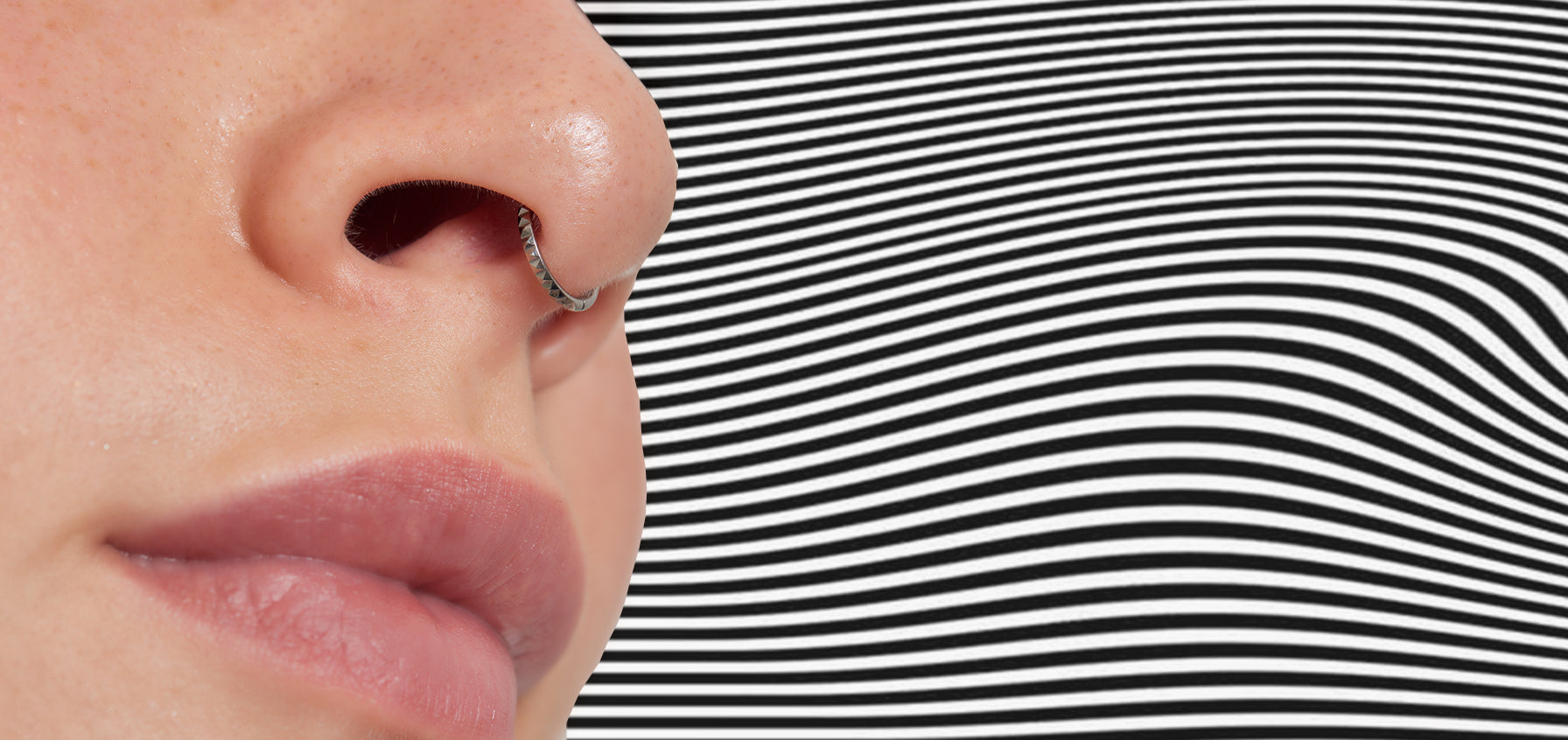
The Simple Guide to 12 Types of Lip Piercings
Lip piercings have come a long way from their tribal origins, evolving into a mainstream trend that has captured the attention of many. This rise in popularity of lip piercings is a testament to the ever-evolving world of self expression.
Before taking the plunge into getting your lip pierced, it's crucial to understand the nuances of the different types of lip piercings available.
This guide aims to demystify the art of lip piercings, providing insight into various lip piercing jewelry and considerations to ensure you make an informed decision.
Types of Lip Piercings
There are 12 main types of lip piercings to choose from, each with their own placement, nuances, and aftercare considerations.
Labret Piercing
A labret piercing is a classic choice, located just below the lower lip, smack-dab in the middle. This piercing is highly versatile, accommodating both labret studs and ring varieties, such as this stunning 16G gold PVD opalize bezel set titanium labret (pictured below).

A “lowbret” piercing sits far below the lower lip, positioned to the left or right. As far as jewelry goes, this piercing will only accommodate labret studs.
Snake bites and spider bites are both considered labret piercings too, but more on those later.
Monroe Piercing
The Monroe piercing, named after the iconic actress and model Marilyn Monroe, replicates the look of her signature beauty mark. It is typically pierced somewhere on the left side above your upper lip using a labret stud.
Achieving the perfect Monroe piercing involves careful consideration of its placement to ensure just the right touch of asymmetry, which is what gives the Monroe its charming appeal.

The most authentic Monroe piercing is placed on the far left above the upper lip, near the natural crease of your smile line. However, some prefer to keep their Monroe piercing closer to the top lip. If you’re a fan of the latter placement, it gives you a bit more jewelry versatility, as it can accommodate a ring as well as a labret stud.
If you prefer the former placement, we recommend a dark-colored labret stud to achieve the authentic look of Marilyn Monroe’s beauty mark, like this 16G black dome top titanium labret (pictured below).

Medusa Piercing
Also called a philtrum piercing, the Medusa is pierced in the dip of your cupid’s bow, directly above the top lip. This location is anatomically known as the “philtrum,” or the two vertical ridges connecting your nose and top lip. Piercing the philtrum can be both striking and elegant, making it a popular choice for those seeking a bold statement. Because of its front-and-center placement, there’s no wrong way to adorn your philtrum piercing.

Some choose a labret stud that’s extremely intricate, filling up more space in the philtrum, like this beaded verge clear CZ titanium threadless labret (shown below). Others choose something more reserved and classic, perhaps coordinating it with other facial piercings.

Madonna Piercing
Similar to the Monroe, the Madonna piercing is placed above the upper lip, but on the right side. The Madonna got its namesake after the American pop legend, Madonna, whose beauty mark was on the right side of her face. While Madonna and Monroe piercings are undoubtedly similar, there are important placement considerations.
Madonna’s beauty mark is above the mouth, slightly off-center under the right nostril. Some prefer the piercing in this placement for authenticity, while others simply mirror the Monroe on the opposite side for symmetry purposes.

Many choose to get a Madonna piercing to honor the Queen of Pop’s impact on music and fashion. Similar to the Monroe, a Madonna piercing uses a labret stud for both your initial piercing and for longtime wear. For a more personalized style, this triple bead titanium threadless labret is both an interesting, sleek choice.

Angel Bites
The angel bites piercing refers to a pair of symmetrical piercings above the upper lip on either side of the cupid’s bow
While “angel bites” is an interesting name, its origins are unknown. For this reason, the angel bites piercing is also called anti-bites and a Monroe/Madonna combo. But regardless of what you call it, perfect symmetry is key to nailing this daring piercing.

In terms of the exact placement, it’s totally up to the piercee. Some prefer them closer to the center, while others prefer them on the outer corners of their mouth.
Your starter jewelry will likely be labret studs, and will most likely continue to be labrets before after the healing process is complete. Typically, angel bites use the same jewelry in both piercings, but it’s not a hard rule.
Another interesting perspective on angel bites is that you don’t have to commit to both piercings at once. It’s perfectly normal to have one side pierced (as a Monroe or Madonna, perhaps) first, allowing you time to accustom yourself to the new piercing. After healing finishes up, you can return to your same piercer to complete the second piercing, if desired. Just make sure it’s symmetrical with your original piercing for the true angel bites aesthetic.
Snake Bites and Spider Bites
Both snake bites and spider bites involve multiple piercings below the lower lip.
A snake bites piercing consists of two symmetrical and equidistant piercings on both sides of the bottom lip. It’s like an angel bites piercing, but reverse! Also similar to angel bites, the placement of snake bites is totally up to the piercee, as long as they’re symmetrical.

A spider bites piercing consists of two side-by-side piercings on only one side of the lower lip. No matter the side you choose, what makes spider bites so distinguishable is that they’re as close together as possible, making it seem as if you were bitten by an actual spider.
Both snake bites and spider bites accommodate labret studs and rings. For either piercing, we think matching blurple anodized titanium captive bead rings are a fantastic fit.

Dahlia Piercing
A dahlia piercing is one of the more unique options, involving a piercing on both corners of the mouth.
Its namesake is gruesome, coming from the infamous 1947 Los Angeles murder of Elizabeth Short, known posthumously as the Black Dahlia. When her body was discovered, it was reported that her mouth had been slashed from its corners up to her ears.
When it comes to the placement, the dahlia can sit closely against the corners of the mouth or further away, depending on your desired style. The distinctive dahlia piercing allows for creative jewelry choices that enhance your facial contours, typically using labret studs to create its iconic look.
But remember: like angel bites and snake bites, symmetry is key for a quintessential dahlia piercing.
Jestrum Piercing
Jestrum piercings are similar to the Meduas, passing through the philtrum (same location as the Medusa) and emerging through the underside of the top lip. In fact, some call the jestrum a “vertical medusa.”
The peek-a-boo nature of this piercing gives you an opportunity to try some really fun jestrum jewelry options. Even though a jestrum piercing only safely accommodates a curved barbell, there are still seemingly endless options that will fit any vibe.
We think the best curved barbell options are those with two different “ends.”
For example, this sepal CZ internally threaded titanium curved barbell has a cubic zirconium cluster on one end and a silver ball on the other. When inserted into the jestrum piercing, it will give the illusion that they’re floating on both sides of the upper lip, one of the main reasons for the jestrum’s widepsread appeal.

Vertical Labret Piercing
A vertical labret piercing is another unique option at your disposal, giving the same “floating” effect as a jestrum piercing. The key difference is that a vertical labret is pierced through your lower lip, while the jestrum is pierced through your top lip.
The vertical labret runs perpendicular to the lower lip, meaning that there are two visible points (below the bottom lip and in the center of the bottom lip), as opposed to just one like the original labret piercing.

When it comes to jewelry options, a vertical labret uses a curved barbell to match the natural curve of your lower lip. An option like this blurple anodized titanium curved barbell would add some colorful flare to an already-popular lip piercing.

Choosing The Right Piercing
When selecting a lip piercing, facial anatomy, personal style, and lifestyle are all factors to be considered.
While each piercing has its own unique charm, what’s right for some may not be right for all. If you’re hesitant, have a chat with your local professional piercer, as they will give you the sound guidance you need to make an informed decision.
Speaking of your piercer, it’s crucial to find reputable, professional piercing studios for a safe and successful experience. Otherwise, you could risk an infection and/or an asymmetrical piercing…two consequences of visiting a bad piercing studio.
Lip Piercing Aftercare
It’s not all up to your piercer, however. Your lip piercing aftercare routine will have just as much to do with the piercing’s success! At minimum, a typical lip piercing will take between 6 and 8 weeks to fully heal. However, the Monroe, Madonna, and Medusa (philtrum) piercings can take 3 months or more to completely heal.
During the healing period, it’s of the utmost importance to clean the piercing area twice daily with saline wound wash, found at any drug store near first aid supplies. Don’t touch the piercing unnecessarily, but if you must, wash your hands thoroughly first.
Be careful to avoid using hydrogen peroxide, isopropyl alcohol, and/or other harsh chemicals on your piercing, as they can irritate the wound. Also take care to avoid antibiotic ointments, as it can suffocate the piercing while trapping in harmful debris.
Lastly, avoid using cotton balls, cotton swabs, rags, or towels directly on your piercing, as they can leave behind fibers that can get trapped in your piercing, causing irritation and/or infection. Instead, use a clean paper towel to blot away excess liquid after cleaning the area and/or bathing.
The proper aftercare, as outlined above, will ensure a smooth recovery and lasting enjoyment of your new lip piercing.
Frequently Asked Questions About Lip Piecings
Q: Do lip piercings hurt?
A: Like any piercing, there will be initial discomfort when you get your lip pierced. There will be a “quick pinch” and some pressure, as to be expected from sticking a sharp needle through your lip! Pain tolerance is unique from person to person, so you’ll be the best judge if you can handle it or not. Chances are, if you have other facial piercings, a lip piercing won’t feel much different.
After the piercing, the area will naturally be sore. Keeping the piercing clean (and still) is the best way to push past the discomfort as fast as possible.
Q: Can I eat and drink normally with a lip piercing?
A: At first, it may seem like eating or drinking is difficult with a lip piercing. But once you’re used to the new addition to your mouth, a lip piercing shouldn’t impede your ability to eat or drink. The best advice we can give you if you’re new to a lip piercing is to take your time while eating and/or drinking to avoid any painful snagging or bumping.
For the first two weeks, the Association of Professional Piercers recommends avoiding any foods or drinks that are spicy, acidic, salty, or very hot in temperature. They also note for lip piercings to be careful of opening your mouth too wide or too fast, as this can cause your jewelry to catch on your teeth.
Q: Will a lip piercing affect my oral hygiene?
A: The short answer is, yes! Any new addition to your mouth area will be at risk of plaque or bacteria buildup. During your healing period, it’s important to continue brushing and flossing your teeth as you normally would. After the initial healing period, the APP recommends using (but not overusing!) mouth rinse.
Q: Can a lip piercing damage my teeth and/or gums?
A: It’s not likely, but your lip piercing could cause minor damage to your teeth and/or gums. Your risk of damage depends on your jewelry size and your mouth’s anatomy. If there are any anatomical concerns, a reputable piercer will discuss them with you prior to piercing.
An important rule is to “downsize” your jewelry as soon as you can (if possible). This is because your piercer might’ve chosen a longer/bigger size of jewelry to accommodate for any swelling post-piercing.
Having that large piece of jewelry in your lip or mouth means a higher risk of contact with your teeth and/or gums, which could cause damage over time. Once the healing period is over, talk to your piercer about what size is right for you.
Q: Is a lip piercing permanent?
A: Nope! Typically, the fresher the piercing, the less “evidence” it will leave behind. At first, after removing your jewelry, the area will show a small perforation and some redness, but it will close and heal over time. Even year-old piercings can close up without any trouble or scarring. However, if your piercing was infected and/or rejected, you may encounter more scarring than usual.
All lip piercings are canvasses for self expression, allowing you to showcase your unique style and personality through jewelry. Whether you opt for a classic labret, a bold Medusa, or a symmetrical pair of angel bites, each piercing tells a story. Never forget that the key to a successful lip piercing lies in choosing the right style, relying on a professional piercer, and finding high-quality body jewelry so you can enjoy your piercing for years to come.

